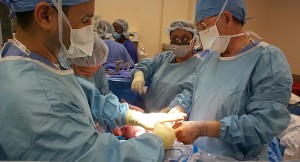On February 2, 2010 California Watch, published a story about California’s maternal mortality rate. It reported the maternal mortality rate in California had increased from 4.3 deaths per 100,000 births in 1996 to 16.9 deaths per 100,000 births in 2006 (the last year statistics are available).
The article cites some factors that are thought to be contributing to this upward trend, and it was not a surprise to me to read that C-sections, and repeat C-sections are one of the main factors officials are finally now considering for the increase in deaths. The article points out that C-sections are now the number one surgical procedure performed in the United States.
How can California, have such a high maternity mortality rate? One would think, after the way modern medicine is used in birth today, that the opposite would be true. This trend is actually not just being seen in California- the entire US maternity mortality rate has also been increasing to the point that it is worse than in some developing countries. As of 2007, the United States ranked 41st in maternity mortality out of 171 countries.
Officials are now conceding that the increasing C-section rate, might have something to do with the maternal mortality death rate. As the California Watch article points out, “doctors face a condition called placenta accreta, where the placenta grows into the scar left by a previous C-section. In surgery, doctors must find and suture a web of twisted placental vessels snaking into the patient’s abdomen, which can hemorrhage alarming amounts of blood. Often, doctors must remove the uterus.”
Along these lines, while researching this blog post, I came across an interesting report from The Joint Commission dated January 10, 2010 on preventing maternal death. It cited a study by the CDC which listed the six leading causes of maternal deaths between 1991 and 1997. The second leading cause was was hemorrhaging, causing 17% of the deaths. The fourth cause was infection at 13%. The report goes on to identify and cites two out of the four common preventable errors that lead to death were: failure to pay attention to vital signs following a C- section, and hemorrhaging following a C-section.
It is interesting that a leading cause of maternal death is hemorrhaging, and one of the most common errors that leads to death is hemorrhaging after a C-section. The CDC reported on these findings thirteen years ago, and officials are just now seriously considering there could be a link between C-sections and a significant rise in the maternal death rate? It doesn’t seem like this has been a hidden fact, or that the research wasn’t being done. This seems more like a case where statistics and research has been emerging for years, but has been largely ignored or brushed off by medical officials. Until now. When California’s maternal death rate is worse than some countries like Bosnia or South Korea.
I have my own theory that the higher a state’s C-section rate is, the higher the maternal death rate will be. While the CDC reports on the C-section rate for every state, not every state publishes their maternal death rates. I could only come up with an handful of state statistics for 2006 on maternal death rates. It’s not enough to draw a definite conclusion. But consider that Pennsylvania had 19 maternal deaths and their C-section rate was 29.7 percent. Washington had 20 maternal deaths and their C-section rate was 28.4 percent. Compare that to California who had 95 maternal deaths and a 31.3 percent C-section rate, and Texas, who had 90 maternal deaths with a 33.2 percent C-section rate.
It’s no secret that other countries who have lower C-section rates also have lower maternal death rates. In Ireland for instance, the C-section rate averages around 21 percent. A joint UN/WHO report in 2007 found that Ireland also had the lowest maternal death rate in the world for women dying during or after pregnancy. Only one out of 47,600 women died, compared with one in 4,800 in the United States. The C-section rate in the United States in 2006 was 31.1 percent. It has been projected (but not confirmed yet) that the C-section rate in the US for 2007 will be 31.8 percent.
The California Watch article tells of a medical director in California, Dr. David Lagrew, who in 2002, banned elective inductions at his facility before 41 weeks or pregnancy, except in rare incidents. Inductions more than double the chances of C-sections. The article says, “as a result, Lagrew said, the operating room schedules opened up, and the hospital saw fewer babies admitted to the neonatal intensive care unit, fewer hemorrhages and fewer hysterectomies.” (bold print mine)
This should have been great news, but as expected, the hospital lost money. On average a C-section costs twice as much as a vaginal birth. Yet, we are constantly told that revenue has nothing to do with the increasing C-section rates. It is because the C-section is “medically necessary.”
If Dr. Lagrew was able to decrease “medically necessary” C-sections in California, right when the maternal death rate was increasing, it ought to be done elsewhere. If Ireland can have the lowest maternal death rate in the world, despite not having all the technological advances that the United States has, and has a considerably lower C-section rate than the United States, that should tell all the officials out there who are trying to figure out why the maternal death rates are increasing, that C-sections are a significant factor in maternal death rates.
It is the white elephant the medical community, and hospitals in general won’t admit, despite research pointing them in this direction for years-decades in some instances. And yet, the C-section rate continues to climb, and more women are dying during pregnancy and childbirth.
I looked up the modern version of the Hippocartic Oath that doctors take upon graduation. After reading these, it is hard to be convinced that most doctors have these oaths in mind in regards to C-sections and births in the United States:
I will apply, for the benefit of the sick, all measures [that] are required, avoiding those twin traps of overtreatment and therapeutic nihilism.
I will remember that there is art to medicine as well as science, and that warmth, sympathy, and understanding may outweigh the surgeon’s knife or the chemist’s drug.
I will not be ashamed to say “I know not,…”
and the last one:
I will respect the privacy of my patients, for their problems are not disclosed to me that the world may know. Most especially must I tread with care in matters of life and death. If it is given me to save a life, all thanks. But it may also be within my power to take a life; this awesome responsibility must be faced with great humbleness and awareness of my own frailty. Above all, I must not play at God.
Maybe it is as simple as that. Maybe if more doctors and hospitals realized a woman’s body is capable in most cases of giving birth without surgery, and let their bodies do what they are capable of doing-just like Dr. Lagrew did, maternal mortality rates would drop in our country. Maybe when “Big Business” gets out of the birthing process, C-section rates will decline, improving maternal health.
The answers to solving the increasing maternal death rate are out there, and have been for years. The question that demands an answer is, when will the majority of the medical community stop ignoring the answers?

